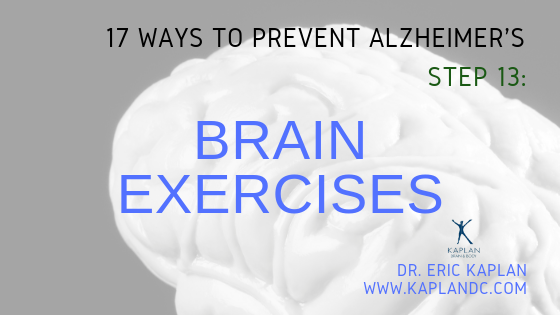To prevent Alzheimer’s Disease it is a priority to discover any areas of the brain that already have weak signals and address those specific areas to make them stronger and function better. In my practice we have technologically advanced equipment to diagnosis areas of the brain that are not functioning at optimal levels. These machines are called Videonystagmography (VNG), CAPS Posturography, Interactive Metronome, Electromyography, Pulse Oximetry, and a Video Balance Board. Using these technologies, we can find areas of the brain that are not working properly and then come up with exercises that are proven through neuroscience to activate those specific areas of the nervous system. For example, if the VNG finds that the frontal cortex is not firing properly, we can do fine finger movements, visual saccades and aromatherapy all at the same time incorporating neuroplastic changes through spatial and temporal summation. Spatial summation is when we perform many exercises at the same time and temporal summation is when we perform these exercises over and over again to create long term potentiation. If we find the right frontal cortex is worse than the left frontal cortex in a hemispheric distribution we would only do the finger exercises on the left side, the saccades to the left and the aromatherapy only in the right nostril. This is very specific and this will get better results. The proper brain exercises can help stop the beginning stages of frontotemporal dementia.
If we find in our evaluation the parietal cortex is not working properly, we will do brain exercises called stereognosis and graphesthesia, two point discrimination, proprioceptive tests, joint position sense, visual pursuits and will start combining multiple exercises to accomplish the spatial summation. If we find temporal cortical issues, we might do memory tests, sound stimulation and balance rehabilitation all at the same. If the occipital cortex is involved we might focus on eye exercises. If the evaluation reveals problems with the fight or flight mode then we might do the gag reflex, gargling exercises, or carotid neck massage to stimulate the glossopharyngeal nerve and the vagus nerve. We might also perform facial rubs, the optic blink reflex or a simple ear rub to activate the facial nerve which is part of the parasympathetic nervous system which helps to calm you down, reduce anxiety, and sleep better. If we do certain eye exercise like convergence, OPK, VORS, Halmagyi maneuver, we can stimulate the ophthalmic nerve to activate the parasympathetic nervous system which may help with high blood pressure and heart disease.
If we find the cerebellum is not functioning correctly we do coordination exercises, move the arms and legs in complicated movements like the infinity symbol or rotate them in a chair. If we are trying to increase activation to the right cerebellum, we would spin them to the right or draw the infinity to the right. If we focus on our treatments on the areas of the brain that aren’t working properly, we can strengthen the weak areas and that will help prevent Alzheimer’s Disease.
My patients are always saying “well I exercise my brain because I do the crossword puzzle every day.” Well, that is good but it may not be specific to the area of the brain that needs work. Because they do it every day, it probably isn’t working on the weak areas, but working on areas that are already strong. That is why we do the evaluation to determine which specific area needs the most work. “If it isn’t broken don’t fix it.” I also like to do exercises that use movement. People always ask me about doing brain exercises on the computer. That is great, but you are still sitting at a computer, tablet or phone rather than moving your body. The brain loves movement. If you want to work your brain while sitting make sure you change it up. Crossword puzzle on Monday, Word Jumble on Tuesday, Sudoku on Wednesday, Word find on Thursday, Maze on Friday, Scrabble on Friday, Lumosity on Saturday, and Memory Match on Sunday for example. The brain loves new activities and increases function with novelty. If you are interested in discovering which areas of your brain are weakest and would like to know the exercises that are most important for you to prevent Alzheimer’s or any other neurological condition, please email me at info@kaplanbrainandbody.com and if you mention this article, you may receive a FREE VNG!
If you are interested in Dr. Kaplan’s services please contact us at 201-261-2150 or visit our website www.kaplandc.com. To download a free copy of Dr. Kaplan’s book visit www.17waystopreventalzheimers.com/download

